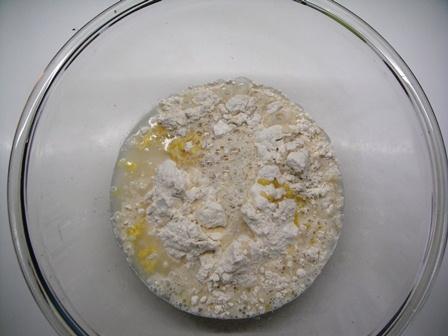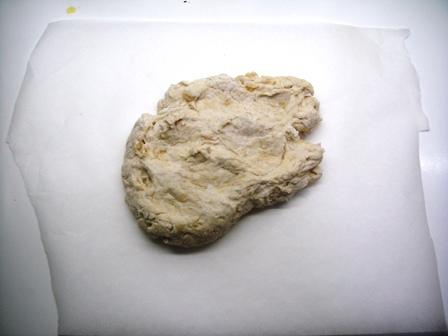
How to make flat loaf plain bread with yeast part 3 – The Accidental Recipe Modified
Saturday 11th June 2011
Recipe 20110611
Flat Loaf Plain Bread Introduction
This time around I made the flat loaf plain bread using the Straight Dough method – that is everything is mixed up together. In the previous experiment (see how to make flat loaf plain bread with yeast part 2) I had made it using the ‘Sponge and Additives’ method (see how to make bread with yeast 3). Using the Straight Dough method is much easier but you need to take care if you are adding a lot of salt or a lot of oil / fats / butter. Yeast does not like salt, nor does it like oils, fats or butter. Too much of this will slow down the fermentation process and the dough will not have enough gases to rise or there will be insufficient fermentation by products to make it flavourful. The Straight Dough Method is much easier as you just need to mix everything together and then just wait. With the Straight Dough method you could try mixing everything together, last thing at night and next morning bake the bread dough. That will enable you to have fresh piping hot bread for breakfast every day. They say that if you had fermented and proofed the bread for too long it may not be as good as if you had limited this period to about 4 hours. So far I have not noticed any difference and that may be because I am adding sugar into most of my recipes. If you do not want the bread to taste sweet or you are worried about diabetes, I would suggest that an alternative to reducing the sugar is to let the dough ferment & proof overnight. That will give time for the yeast to consume most if not all the sugar and give the bread more aromatic flavours.
The Flat Loaf Plain Bread recipe is as follows – the Straight Dough Method.
| Item | Ingredients | Percentage | Weight | Weight | |
| (%) | (g) | oz. | |||
| Sponge | |||||
| 1 | Bread Flour | 100 | 300 | 10.56 | |
| 3 | Instant Dry Yeast | 2 | 6 | 0.21 | |
| 4 | Sugar | 7 | 21 | 0.74 | |
| 5 | Water, Cold | 80 | 240 | 8.45 | |
| Additives | |||||
| 6 | Salt | 1.5 | 4.5 | 0.16 | |
| 7 | Butter | 2 | 6 | 0.21 | |
| 8 | Virgin Coconut Oil | 2 | 6 | 0.21 | |
| 9 | Olive Oil | 2 | 6 | 0.21 | |
Photos of flat loaf plain bread making process

Stir in all the dry ingredients so that they are well distributed within the flour then add the soft butter and oils.

Add the water and mix.

Fold the sponge on its self a few times until it becomes one clump.

Cut out a sheet of baking paper the size of the baking tray and place the dough onto the baking sheet. Flatten the dough with your spoon. Don’t put the dough and baking sheet into the baking tray just yet as there is another step to be carried out and this step is easily done on your kitchen top work surface.

I told you that this is a flat loaf, right? So here is how I managed to flatten it. If you used your hands the ‘water breaks’ and comes out and the dough will be very sticky. I sprinkled some flour on the dough and rubbed my rolling pin with flour. Then I used the rolling pin to flatten the dough. It almost looks like a pizza. Those little bits on the top are the bits of dough I scrapped off the rolling pin on my first attempt to use the rolling pin without using flour. Yes, yes, yes, you can shape high water content dough!

Now you can see why the baking paper was necessary. I used the baking paper to lift the flatten dough into the baking tray. You will notice that there are some yellowish stains on the dough. Those stains are the olive oil and butter patches.

After four and a half hours of proofing the dough had risen quite a bit.

This is the final product, the flat loaf plain bread. It was baked for 40 minutes at 230C (446F) and it did rise a little more during baking. I tried a high bake temperature as I wanted to get the water in the dough to steam quickly and push the dough upward. That means the flat loaf plain bread can be baked anywhere from 210C (410F) to 230C (446F) for about 40 to 45 minutes without much difference.

This flat loaf plain bread turned out quite well.
This article “How to make flat loaf plain bread with yeast part 3” was researched and written by Peter Achutha.
Leave a Reply